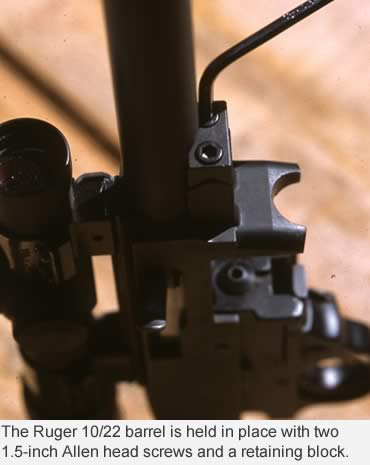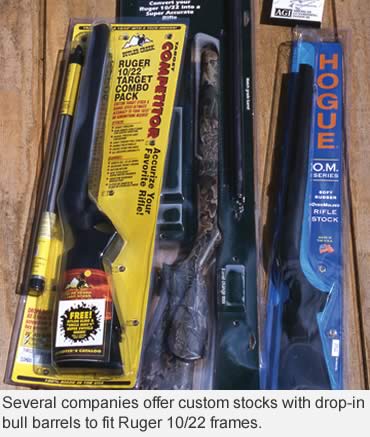With just a few simple tools, you can build a semi-custom .22 that looks good and shoots great.
The Ruger 10/22 rimfire rifle was heralded as a masterpiece in firearm design when it hit the market in 1964. The 5-pound semiauto was easy to work on and featured a 10-round rotary magazine that fit flush in the stock’s action well, precisely at the gun’s balance point.
The package has changed very little over the intervening four-plus decades and stands today as the most popular rifle ever made, with nearly 5 million in circulation.
The gun’s Spartan design, extreme durability and low price make it the second most-customized firearm today, topped only by the 1911 pistol. Anyone with a tinkerer’s bent and a few tools can build their own 10/22.
The gun can be completely disassembled with a screwdriver, a 5/32-inch Allen wrench and a drift punch. Such do-it-yourself simplicity has, over the last 25 years, spawned a cottage industry in custom accessories and services.
Bell & Carlson, Butler Creek, Hogue, Choate, Clark Custom and Battenfeld (Midway-Fajen) offer exceedingly simple drop-in stock-and-barrel kits that require virtually no skills or firearms knowledge to install.
You can also get improved cross pins, recoil buffers and trigger components, bolt and magazine accessories from Volquartsen, Power Custom, Clark Custom, Brownells, MidwayUSA, KIDD and others — some of which may require at least a basic understanding of firearms anatomy to install.
Upgrades of 10/22s can be done with $35 worth of components. I’ve also tricked them out at a cost well into four figures.
The Barrel
The 10/22’s factory barrel, with its industry-standard 1-in-16 rifling twist rate, affords better-than-passable accuracy. The lifespan, according to 10/22 aficionados, is 300,000 to 500,000 shots — the first 60,000 or so at peak accuracy. That’s plenty when you consider that the average shooter is hard-pressed to put more than 2,000 rounds through a rimfire rifle in a lifetime.
Heavier and/or stiffer barrels dampen harmonics, which, along with some other factors, provides superior accuracy. Aftermarket barrels for the 10/22 are commonly classified as ultralight (less than 25 ounces), standard weight (25-35 ounces) and heavyweights (more than 48 ounces).
Two guns recently went through my shop, one mounted with an 18-inch Green Mountain Aero barrel that weighs 21 ounces, and another at the other extreme with a 20-inch Green Mountain .920-inch-diameter steel barrel that weighs 3 pounds, 4 ounces.
Very accurate 44-ounce target barrels, and thinner sporter barrels, are available from Green Mountain, Volquartsen, E.R. Shaw, Adams & Bennett, KIDD, Hart, Jarvis, Whistle Pig, Lilja, Lothar-Walther, Shilen, Douglas and others. Blued and stainless barrels are offered, either fluted or round, in lengths up to 21 inches. Carbon-fiber barrels are another option. Most simply bolt into the V-block retainer in the action; others offer threaded tenons and receivers.
The tenon on my Green Mountain Aero barrel had to be polished, then tapped into place with a rubber mallet. The heavy Green Mountain barrel simply slipped into the receiver with no coaxing.
Bolting or otherwise affixing the barrel to the receiver assures free-floating, but only in light barrels. If you’re mounting a heavy aftermarket barrel, the bolts won’t be sufficient to bear the weight when free-floated. These barrels should be bedded in the forearm for better support. I commonly use a bedding kit from Volquartsen for that purpose, although many aftermarket stocks incorporate contact blocks and pressure pads in the forearm.
 The receiver-barrel mating of the Ruger 10/22 tends to cause a slight droop that can make getting sufficient scope elevation difficult. This can be remedied by replacing the barrel-retention block with an elevator block from Gunsmither Tools, or by mounting a slightly sloped scope rail like the Tactical Solutions’ 15 MOA.
The receiver-barrel mating of the Ruger 10/22 tends to cause a slight droop that can make getting sufficient scope elevation difficult. This can be remedied by replacing the barrel-retention block with an elevator block from Gunsmither Tools, or by mounting a slightly sloped scope rail like the Tactical Solutions’ 15 MOA.
The tight-fitting Green Mountain Aero barrel free-floated easily on the factory receiver. Its light weight was easily supported by the retention bolts. The 20-inch Green Mountain steel barrel was too heavy to free-float with just the retention bolts, so I bedded the barrel in the stock’s forearm.
Very little barrel material is needed to contain the pressure of the .22 Long Rifle. Steel barrel liners as thin as .030 inch are commonly used in tensioned aluminum or carbon-fiber barrels. These offer the stiffness of a heavy steel bull barrel without the weight. Magnum Research offers a .920-inch carbon-sleeved tensioned barrel that weighs just 12.8 ounces.
A quality tensioned fiber-wrapped or aluminum-shrouded barrel is, in my experience, every bit as accurate as most heavy steel barrels. In fact, my favorite squirrel gun is a 10/22 conversion fitted with a 16-inch cantilevered Volquartsen carbon-fiber tension barrel and a firing kit (hammer, spring, trigger) from the same shop.
Green Mountain’s unique Aero barrel systems consist of a very slender but stiff 16-inch stainless-steel barrel surrounded by a .920-inch polished aluminum sleeve that extends about 7/8 inch farther than the barrel. The Aero’s inner barrel has shallow flutes, a Bentz chamber (improves accuracy in autoloading rimfires) and has a unique 1-in-15-inch twist rate. The barrel is also cryogenically treated to stiffen it and relieve stress.
Higher-quality aftermarket barrels tend to be hand-lapped, a polishing process that removes tooling marks and other inconsistencies that can degrade accuracy. But there are plenty of less-expensive barrels on the market that are not lapped. To make those shoot to their potential, I commonly use a NECO Lap fire-lapping system, which consists of .22 LR cartridges containing bullets tipped with three grades of abrasive polishing compound.
Although the Green Mountain .920-inch barrel looked smooth through a borescope, I fire-lapped the bore with a NECO kit, and the resulting accuracy was outstanding.
I installed a Volquartsen trigger kit on the Aero-barreled rifle and fitted the action in a Fajen Legacy stock. Extended magazine releases were fitted to both rifles.
The heavy 20-inch Green Mountain barrel was fitted to a factory receiver and into a Hogue Over Molded stock. The fire-control system was upgraded with a Clark Custom trigger kit. The steel bolt stop in both guns were replaced by polymer recoil buffers, which soften the trauma of the recoiling bolt and tend to quiet the cycling event.
 The carbon-fiber barrels I’ve mounted on other guns are light yet strong. Lothar-Walther sells an extremely light Aluma-Lite 18-inch barrel made by Majestic Arms. Milled out of 6160 aircraft aluminum and having a steel insert, the barrel promises half-inch groups at 50 yards. Similar barrels weighing a little more than a pound are offered by Volquartsen and Tactical Solutions.
The carbon-fiber barrels I’ve mounted on other guns are light yet strong. Lothar-Walther sells an extremely light Aluma-Lite 18-inch barrel made by Majestic Arms. Milled out of 6160 aircraft aluminum and having a steel insert, the barrel promises half-inch groups at 50 yards. Similar barrels weighing a little more than a pound are offered by Volquartsen and Tactical Solutions.
A lightweight barrel can make a rifle more versatile. My Volquartsen-based conversion is a delight to tote and shoot in the squirrel woods and performs extremely well in silhouette competition.
The 10/22 receivers are drilled and tapped for scope rails, but many aftermarket barrels are cantilevered, and most aftermarket receivers have integral scope mounts. I mount a Pentax Lightseeker 0/XV scope for squirrel hunting and replace it with a Pentax Lightseeker 6-24x target scope for silhouettes.
In addition to the .920-inch-diameter steel or tensioned barrels, there are also standard-weight or sporter barrels that fit the barrel channel dimension of the factory stock. You may also find muzzle-weighted or running bore barrels. These add to the weight-forward stability sought in offhand shooting. Green Mountain, Ranch Products and Volquartsen make them.
Volquartsen also sells a counter weight to attach to the muzzle of its .920-diameter barrels.
Many companies offer ported compensators for the muzzles, marketed with boasts of limited recoil and barrel jump. Since a .22 LR offers no recoil or barrel jump, compensators speak more to aesthetics than function.
Venturing Farther
A variety of other components make the 10/22 more durable, quiet, accu- rate and convenient to use.
I routinely replace the action pins with oversized models from Brownells or KIDD. The original pins are often so loose that they drop out when the stock is removed. The aftermarket pins soften accuracy-robbing vibration.
One of the most frustrating facets of operating the 10/22 is removing the flush-fit magazine from its well. For those with sausage fingers, or if you’re wearing gloves, it can be maddening. I therefore routinely install an extended magazine release on any 10/22 in my shop.
Like making apple pie from Ritz crackers, one can now build a custom version of the Ruger 10/22 without even using a 10/22 as a foundation. A truly custom gun can be built virtually from scratch, using receivers from Volquartsen, KIDD, MOA or Tactical Solutions; bolts and other hardware from KIDD, Volquartsen, Power Custom, et al; a variety of fire-control systems from various sources; barrels, stocks, magazine releases, etc. from throughout the aftermarket.
There are even conversion kits from companies like SKS Man that turn the venerable 10/22 into a fully automatic machine gun of questionable legality with a clever trigger kit or a crank mounted on the trigger.
In the next issue of GunHunter, we’ll look at more facets of customizing the 10/22 and even converting it to a .17-caliber rimfire. Whatever your designs for Ruger’s versatile 10/22, it’s simply too tantalizing to leave as is.
Ultimate 10/22 Aftermarket Sources
It’s no exaggeration to say that an amateur or professional gunsmith can find virtually whatever he needs in Brownells or Midway USA’s catalogs, the primary purveyors of anything even remotely associated with guns and gunsmithing.
They are also the ultimate sources for most anything associated with the aftermarket for Ruger 10/22 firearms, including parts and accessories produced by companies too small or specialized to have catalogs of their own.
The industry should celebrate the day Iowa gunsmith Bob Brownell decided to become a distributor for the myriad small specialty gunsmithing and toolmaking shops 60 years ago. The 60th annual catalog has more than 500 pages and lists 30,000-plus tools, parts, books, videos, etc. — as well as advice.
Brownells products and tools always come with expert step-by-step advice on their use and function. The company also has easy-to-reach customer service staff of actual gunsmiths who have bailed me out of more jams than I care to remember.
Midway Shooting Supplies, which has been a solid resource for shooters, reloaders and hunters for years, now devotes nearly 300 pages of its Master Catalog to aftermarket and gunsmithing items, parts and accessories.
Both companies assisted greatly in the compilation of the articles on the Ruger 10/22 aftermarket. — Dave Henderson
This article was published in the September 2008 edition of Buckmasters GunHunter Magazine. Subscribe today to have GunHunter delivered to your home.